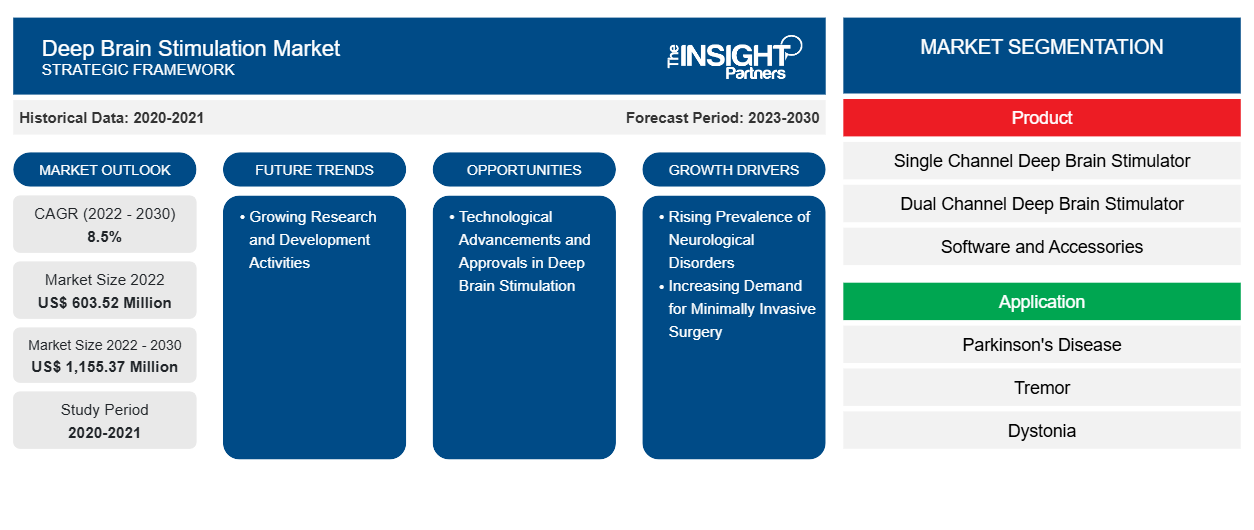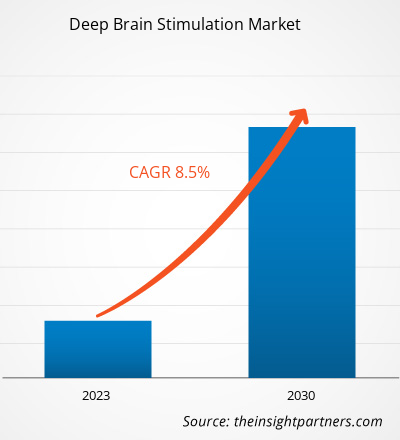[研究报告] 深部脑刺激市场预计将从 2022 年的 6.0352 亿美元增长,到 2030 年预计将达到 11.5537 亿美元的价值;预计 2022 年至 2030 年的复合年增长率为 8.5%。 CAGR of 8.5% from 2022 to 2030.
市场洞察和分析师观点:
深部脑刺激器 (DBS) 是一种脑刺激装置,包括一个脑部起搏器(一种可植入脉冲发生器),它通过手术植入的电极向脑部特定目标发送电刺激。DBS 通常用于治疗运动障碍和神经精神疾病。神经系统疾病患病率的上升和对微创手术的需求的增加推动了深部脑刺激市场规模的增长。然而,与深部脑刺激相关的副作用阻碍了深部脑刺激市场的增长。神经系统疾病患病率的上升和对微创手术的需求的增加预计将在预测期内推动深部脑刺激市场的增长。
增长动力和挑战:
老年人群易患神经系统疾病。神经病、帕金森病、阿尔茨海默病和肌张力障碍是影响老年人最常见的神经系统疾病。根据美国国立卫生研究院 (NIH) 的数据,世界人口中有 8.5%(即约 6.17 亿人)年龄在 65 岁及以上。在美国和加拿大等国家,老年人群中运动障碍和精神疾病的发病率很高。根据世界卫生组织 (WHO) 的数据,神经系统疾病占全球疾病负担的 6.3%,是全球主要死亡原因之一。此外,发达国家 13.2% 的死亡和中低收入国家 16.8% 的死亡都与神经系统疾病有关。
深部脑刺激是一种微创靶向手术,用于治疗肌张力障碍、帕金森病和特发性震颤等运动障碍。微创手术 (MIS) 比传统手术技术具有多种优势。MIS 可最大限度地减少对身体的创伤、减轻术后疼痛、加快恢复速度并改善疗效。此外,这些手术需要足够大的微小切口来插入细管和摄像头。MIS 的这些优势正在增加住院患者,并鼓励面临高手术发病率和死亡率的老年患者寻求手术。因此,人们对神经系统疾病负担的认识不断提高、老年人口不断增加、神经系统疾病患病率不断上升以及由于微创手术的优势而对微创手术的需求不断增加,推动了对深部脑刺激器作为一种治疗方法的需求。
定制此报告以满足您的需求
您可以免费定制任何报告,包括本报告的部分内容、国家级分析、Excel 数据包,以及为初创企业和大学提供优惠和折扣
- 获取此报告的关键市场趋势。这个免费样品将包括数据分析,从市场趋势到估计和预测。
深部脑刺激 (DBS) 可有效治疗多种神经和精神疾病;然而,手术和硬件相关的不良事件 (AE) 会对生活质量产生负面影响。患者在接受 DBS 手术后的最初几周和几个月内可能会出现副作用,具体取决于他们的药物和初始编程。患者通常会感到与植入在锁骨附近皮肤下的设备神经刺激器(或电池组)相关的不适。接受双侧 DBS 的患者比接受单侧 DBS 的患者副作用明显更常见。深部脑刺激手术存在各种风险,例如导线错位和脑出血。植入式脉冲发生器 (IPG) 是 DBS 设备的基本能量源和可配置组件。IPG 的感染风险限制了深部脑刺激设备在帕金森病中的应用。因此,深部脑刺激的副作用阻碍了深部脑刺激市场的增长。
报告细分和范围:
全球深部脑刺激市场根据产品、应用、最终用户和地域进行细分。基于产品,深部脑刺激市场细分为单通道深部脑刺激器、双通道深部脑刺激器以及软件和系统。基于应用,深部脑刺激市场细分为帕金森病、震颤、阿尔茨海默病、肌张力障碍、癫痫等。基于最终用户,深部脑刺激市场细分为医院、神经病学诊所、门诊手术中心等。基于地域的深部脑刺激市场细分为北美(美国、加拿大和墨西哥)、欧洲(德国、法国、意大利、英国、西班牙和欧洲其他地区)、亚太地区(澳大利亚、中国、日本、印度、韩国和亚太地区其他地区)、中东和非洲(南非、沙特阿拉伯、阿联酋和中东和非洲其他地区)以及南美洲和中美洲(巴西、阿根廷和南美洲和中美洲其他地区)。
节段分析:
根据产品,深部脑刺激市场细分为单通道深部脑刺激器、双通道深部脑刺激器以及软件和系统。双通道深部脑刺激器细分市场在 2022 年占据最大市场份额;此外,预计同一细分市场在预测期内的复合年增长率最高,为 9.5%。双通道 DBS 提供最佳的整体支持,并有效减少患者的震颤。美敦力的 Kinetra 内部脉冲发生器 (IPG) 是第一款双通道 IPG,于 1998 年上市。双通道 DBS 越来越多地用于治疗各种神经系统疾病,例如肌张力障碍、帕金森病、阿尔茨海默病和癫痫,这是推动该细分市场增长的关键因素。此外,产品审批正在推动双通道刺激器细分市场的增长。例如,2020 年 1 月,雅培的 Infinity DBS 系统获得 FDA 批准用于治疗帕金森病。该系统专门针对大脑内部苍白球 (GPi),这与帕金森病症状有关。此外,波士顿科学公司的 Vercise、Vercise PC 和 Vercise Gevia DBS 系统;美敦力公司的 Activa PC 和 Activa RC;以及雅培公司的 Infinity 是该领域的几款主要产品。因此,双通道刺激的优势以及产品批准预计将在预测期内推动双通道深部脑刺激器领域的增长。
根据应用,深部脑刺激市场细分为帕金森病、震颤、阿尔茨海默病、肌张力障碍、癫痫等。帕金森病细分市场在 2022 年占据了最大的市场份额,预计同一细分市场在预测期内的复合年增长率最高,为 8.5%。帕金森病 (PD) 是一种神经系统疾病,会导致行走、协调和平衡困难以及颤抖和僵硬。美国食品和药物管理局 (FDA) 批准的深部脑刺激疗法数量不断增加、全球患有 PD 的患者数量激增以及 DBS 产品获批数量不断增加等一些因素预计将在未来几年支持该细分市场的增长。例如,根据帕金森基金会的估计,每年约有 60,000 名美国人被诊断出患有 PD。此外,美国有 100 万人患有 PD,预计到 2030 年这一数字将达到 120 万。全球有各种创新产品推出。例如,2021 年 1 月,美敦力启动了首创的自适应深部脑刺激 (aDBS) 试验,以评估自适应深部脑刺激对 PD 患者的安全性和有效性。因此,上述因素在预测期内显著增强了深部脑刺激市场的增长。
根据最终用户,深部脑刺激市场细分为医院、神经科诊所、门诊手术中心等。医院部门在 2022 年占据了最大的市场份额,预计同一部门在预测期内的复合年增长率最高,为 9.1%。由于帕金森病和阿尔茨海默病等各种神经系统疾病的患病率不断上升,以及医院环境中的熟练专业人员可以有效治疗的其他疾病,医院部门预计将大幅增长。医院进行的深部脑刺激 (DBS) 手术数量有所增加,医院环境中拥有最先进的设施。根据 2021 年发表的一项题为“运动障碍的单阶段深部脑刺激器放置”的研究,全球约有 160,000 名患者因各种神经和非神经系统疾病接受了 DBS,每年约有 12,000 名新患者接受 DBS。此外,医院还聘用了最优秀的专业人员,包括技术娴熟、经验丰富的神经科医生、护士和技术人员,他们齐心协力,在舒适的环境中为患者提供最好的手术护理。因此,在预测期内,技术先进的 DBS 设备的可用性以及优惠的报销政策预计将推动医院部门的发展。
区域分析:
根据地域,深部脑刺激市场分为五个主要区域——北美、欧洲、亚太地区、南美和中美以及中东和非洲。2022 年,北美占据全球深部脑刺激市场的最大份额。北美深部脑刺激市场分为美国、加拿大和墨西哥。美国拥有最大的深部脑刺激市场份额,预计在预测期内将实现最高的复合年增长率。市场增长归因于帕金森病 (PD) 等神经系统疾病患病率的上升、对神经系统疾病认识的提高以及对开发颅内刺激器的投资不断增加。根据美国阿尔茨海默病协会发布的《2022 年阿尔茨海默病事实与数据》研究显示,2022 年美国约有 650 万 65 岁以上患者患上阿尔茨海默病,预计到 2060 年这一数字将上升至 1,380 万。此外,根据帕金森基金会的数据,美国约有 100 万人患有帕金森病,预计到 2030 年这一数字将达到 120 万。
欧洲是第二大深部脑刺激市场。由于主要区域深部脑刺激公司推出的创新产品增多,欧洲深部脑模拟市场正在经历快速增长。2020 年 6 月,美敦力宣布推出采用 BrainsenseTM 技术的 PerceptTM PC 神经刺激器。该技术同时记录并向大脑传送电刺激,以缓解帕金森病 (PD) 的症状。预计德国和英国将见证该地区 DBS 市场的增长。预计亚太地区深部脑刺激市场在预测期内的复合年增长率最高。DBS 领域创新技术趋势的不断增加以及人工智能 (AI) 和机器学习 (ML) 的快速采用是推动该地区市场增长的关键因素。2023 年 2 月,中国国家药品监督管理局批准了 NERVTEX,该公司专门开发脑部疾病的数字治疗方法,例如用于分析运动障碍的人工智能软件。此外,运动功能障碍评估软件(MoDAS)是一种医疗设备,用于分析用手机记录的患者运动活动。然后提供事实和数字数据来诊断和管理患者的运动。
深部脑刺激市场区域洞察
Insight Partners 的分析师已详细解释了预测期内影响深部脑刺激市场的区域趋势和因素。本节还讨论了北美、欧洲、亚太地区、中东和非洲以及南美和中美洲的深部脑刺激市场细分和地理位置。

- 获取深部脑刺激市场的区域特定数据
深部脑刺激市场报告范围
| 报告属性 | 细节 |
|---|---|
| 2022 年市场规模 | 6.0352亿美元 |
| 2030 年的市场规模 | 11.5537亿美元 |
| 全球复合年增长率(2022 - 2030 年) | 8.5% |
| 史料 | 2020-2021 |
| 预测期 | 2023-2030 |
| 涵盖的领域 | 按产品
|
| 覆盖地区和国家 | 北美
|
| 市场领导者和主要公司简介 |
|
深部脑刺激市场参与者密度:了解其对业务动态的影响
深度脑刺激市场正在快速增长,这得益于终端用户需求的不断增长,而这些需求又源于消费者偏好的不断变化、技术进步以及对产品优势的认识不断提高等因素。随着需求的增加,企业正在扩大其产品范围,进行创新以满足消费者的需求,并利用新兴趋势,从而进一步推动市场增长。
市场参与者密度是指在特定市场或行业内运营的企业或公司的分布情况。它表明在给定市场空间中,相对于其规模或总市场价值,有多少竞争对手(市场参与者)存在。
在深部脑刺激市场运营的主要公司有:
- 雅培实验室
- Aleva神经治疗公司
- 美敦力公司
- 北京品致医疗科技有限公司
- 波士顿科学公司
免责声明:上面列出的公司没有按照任何特定顺序排列。

- 了解深部脑刺激市场顶级关键参与者概况
COVID-19 影响:
为了减少 COVID-19 的传播,脑部手术被推迟甚至取消。根据 2020 年 3 月的总理令,意大利的遏制措施导致常规医院活动减少。在受疫情影响最严重的国家,例如美国、印度、巴西、法国、英国、意大利和西班牙,神经外科手术下降了 55%。COVID-19 大流行对深部脑刺激市场产生了负面影响。2020 年 12 月,根据国家生物技术信息中心的报告,封锁限制措施将人们限制在家中,并记录了运动和精神症状的主观恶化,例如患有帕金森病和肌张力障碍并接受 DBS 治疗的患者出现睡眠问题。这些限制导致神经系统疾病负担增加以及与 DBS 管理相关的慢性压力。随着封锁限制的放松,医疗保健专业人员重新开始恢复脑部手术。疫情过后,全球范围内远程会诊活动增多,以跟踪 PD 患者的症状,并进行常规检查,这对增加对深部脑刺激等治疗方案的需求起着关键作用。因此,预计此类趋势将在未来几年影响 DBS 的采用,并在预测期内继续大幅增长。
竞争格局和重点公司:
全球深部脑刺激市场的一些知名企业包括雅培实验室、Aleva Neurotherapeutics SA、美敦力公司、北京品思医疗有限公司、波士顿科学公司、Newronika SpA 和 SceneRay Co Ltd。这些公司专注于新产品的推出和地域扩张,以满足全球日益增长的消费者需求,并增加其专业产品组合的产品范围。它们在全球拥有广泛的业务,这使它们能够服务于大量客户,从而增加了其深部脑刺激市场份额。
- 历史分析(2 年)、基准年、预测(7 年)及复合年增长率
- PEST 和 SWOT 分析
- 市场规模价值/数量 - 全球、区域、国家
- 行业和竞争格局
- Excel 数据集



Report Coverage
Revenue forecast, Company Analysis, Industry landscape, Growth factors, and Trends

Segment Covered
This text is related
to segments covered.

Regional Scope
North America, Europe, Asia Pacific, Middle East & Africa, South & Central America

Country Scope
This text is related
to country scope.
常见问题
The factors driving the growth of the deep brain stimulation market include the rising prevalence of neurological disorders and increasing demand for minimally invasive surgery. However, the side effects associated with deep brain stimulation hamper the growth of the deep brain stimulation market.
A deep brain stimulator (DBS) is a device comprising a brain-oriented pacemaker that sends electrical stimulation through surgically-implanted electrodes to specific targets in the brain. DBSs are commonly used to treat movement disorders as well as neuropsychiatric disorders.
The deep brain stimulation market was valued at US$ 603.52 million in 2022.
The deep brain stimulation market is expected to be valued at US$ 1,155.37 million by 2030.
The deep brain stimulation market majorly consists of the players, including Abbott Laboratories, Aleva Neurotherapeutics SA, Medtronic Plc, Beijing PINS Medical Co Ltd, Boston Scientific Corp, Newronika SpA, and SceneRay Co Ltd.
The deep brain stimulation market, based on product, is segmented into single-channel deep brain stimulators, dual-channel deep brain stimulators, and software and accessories. The dual-channel deep brain stimulators segment held the largest market share in 2022 and is anticipated to register the highest CAGR during the forecast period.
Trends and growth analysis reports related to Life Sciences : READ MORE..
The Insight Partners performs research in 4 major stages: Data Collection & Secondary Research, Primary Research, Data Analysis and Data Triangulation & Final Review.
- Data Collection and Secondary Research:
As a market research and consulting firm operating from a decade, we have published and advised several client across the globe. First step for any study will start with an assessment of currently available data and insights from existing reports. Further, historical and current market information is collected from Investor Presentations, Annual Reports, SEC Filings, etc., and other information related to company’s performance and market positioning are gathered from Paid Databases (Factiva, Hoovers, and Reuters) and various other publications available in public domain.
Several associations trade associates, technical forums, institutes, societies and organization are accessed to gain technical as well as market related insights through their publications such as research papers, blogs and press releases related to the studies are referred to get cues about the market. Further, white papers, journals, magazines, and other news articles published in last 3 years are scrutinized and analyzed to understand the current market trends.
- Primary Research:
The primarily interview analysis comprise of data obtained from industry participants interview and answers to survey questions gathered by in-house primary team.
For primary research, interviews are conducted with industry experts/CEOs/Marketing Managers/VPs/Subject Matter Experts from both demand and supply side to get a 360-degree view of the market. The primary team conducts several interviews based on the complexity of the markets to understand the various market trends and dynamics which makes research more credible and precise.
A typical research interview fulfils the following functions:
- Provides first-hand information on the market size, market trends, growth trends, competitive landscape, and outlook
- Validates and strengthens in-house secondary research findings
- Develops the analysis team’s expertise and market understanding
Primary research involves email interactions and telephone interviews for each market, category, segment, and sub-segment across geographies. The participants who typically take part in such a process include, but are not limited to:
- Industry participants: VPs, business development managers, market intelligence managers and national sales managers
- Outside experts: Valuation experts, research analysts and key opinion leaders specializing in the electronics and semiconductor industry.
Below is the breakup of our primary respondents by company, designation, and region:

Once we receive the confirmation from primary research sources or primary respondents, we finalize the base year market estimation and forecast the data as per the macroeconomic and microeconomic factors assessed during data collection.
- Data Analysis:
Once data is validated through both secondary as well as primary respondents, we finalize the market estimations by hypothesis formulation and factor analysis at regional and country level.
- Macro-Economic Factor Analysis:
We analyse macroeconomic indicators such the gross domestic product (GDP), increase in the demand for goods and services across industries, technological advancement, regional economic growth, governmental policies, the influence of COVID-19, PEST analysis, and other aspects. This analysis aids in setting benchmarks for various nations/regions and approximating market splits. Additionally, the general trend of the aforementioned components aid in determining the market's development possibilities.
- Country Level Data:
Various factors that are especially aligned to the country are taken into account to determine the market size for a certain area and country, including the presence of vendors, such as headquarters and offices, the country's GDP, demand patterns, and industry growth. To comprehend the market dynamics for the nation, a number of growth variables, inhibitors, application areas, and current market trends are researched. The aforementioned elements aid in determining the country's overall market's growth potential.
- Company Profile:
The “Table of Contents” is formulated by listing and analyzing more than 25 - 30 companies operating in the market ecosystem across geographies. However, we profile only 10 companies as a standard practice in our syndicate reports. These 10 companies comprise leading, emerging, and regional players. Nonetheless, our analysis is not restricted to the 10 listed companies, we also analyze other companies present in the market to develop a holistic view and understand the prevailing trends. The “Company Profiles” section in the report covers key facts, business description, products & services, financial information, SWOT analysis, and key developments. The financial information presented is extracted from the annual reports and official documents of the publicly listed companies. Upon collecting the information for the sections of respective companies, we verify them via various primary sources and then compile the data in respective company profiles. The company level information helps us in deriving the base number as well as in forecasting the market size.
- Developing Base Number:
Aggregation of sales statistics (2020-2022) and macro-economic factor, and other secondary and primary research insights are utilized to arrive at base number and related market shares for 2022. The data gaps are identified in this step and relevant market data is analyzed, collected from paid primary interviews or databases. On finalizing the base year market size, forecasts are developed on the basis of macro-economic, industry and market growth factors and company level analysis.
- Data Triangulation and Final Review:
The market findings and base year market size calculations are validated from supply as well as demand side. Demand side validations are based on macro-economic factor analysis and benchmarks for respective regions and countries. In case of supply side validations, revenues of major companies are estimated (in case not available) based on industry benchmark, approximate number of employees, product portfolio, and primary interviews revenues are gathered. Further revenue from target product/service segment is assessed to avoid overshooting of market statistics. In case of heavy deviations between supply and demand side values, all thes steps are repeated to achieve synchronization.
We follow an iterative model, wherein we share our research findings with Subject Matter Experts (SME’s) and Key Opinion Leaders (KOLs) until consensus view of the market is not formulated – this model negates any drastic deviation in the opinions of experts. Only validated and universally acceptable research findings are quoted in our reports.
We have important check points that we use to validate our research findings – which we call – data triangulation, where we validate the information, we generate from secondary sources with primary interviews and then we re-validate with our internal data bases and Subject matter experts. This comprehensive model enables us to deliver high quality, reliable data in shortest possible time.


 获取此报告的免费样本
获取此报告的免费样本